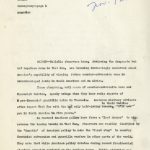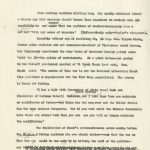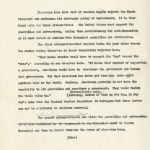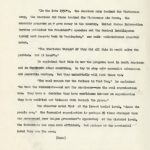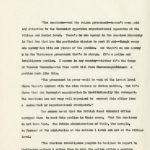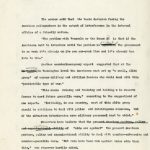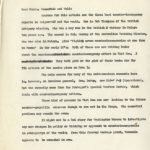1964, November 12, “Counter-Subversive Wars”
Beverly Deepe
101 Cong Ly
Saigon
insurgency–page 1 Nov. 12
page 1xm
SAIGON–Reliable observers here, reviewing the desperate but not hopeless mess in Viet Nam, are becoming increasingly concerned about America’s capability of winning future counter-subversive wars in underdeveloped lands in South American and Av Africa.
These observers, well aware of counter-subversive wars and Communist tactics, openly cringe when they hear radio reports of C pro-Communist guerrilla raids inVenezuela. American military advisors often depart Viet Nam with the hal only half-joking remark to their buddies, “I’ll see you in South America in five years.”
As current American policy here faces a “last chance” to win reverse the losing trends in Viet Nam, observers are readily distrubed by the “inertia” of American policy to make the “first step” to counter Communist subversion and guerrilla warfare in other parts of the world. they note that while American policy debates during recent Presidential election campaign centered on the nuclear issue, little attention was ofu focused on what they call here “the war of the future.” Even ranking
deepe
insurgency–2
Even ranking American military men, who openly advocated almost a decade ago that American should become less dependent on nuclear arms and capability tonow admitregret that the problems of counter-insurgency were n not then met “with any sense of urgency.” (Informatively only–Taylor‘s viewpoint).
Possibly without rea li realizing it, Ge Maj. Gen. Nguyen Khanh, former prime minister and now commander-in-chief of Vietnamese armed forces, has vigorously questioned the very basis of American foreign policy since World War II–the policy of containment. In a quiet lotus-pond garden int he far-off provincial cpaital of Vi Thanh Thanh last week, Gen. Khanh said: “The source o this war is not the National Liberation Front (the political x organization for the Viet Cong guerrillas). The source is Hanoi and Peking.
“I had to talk with (Secretary of State Dean) Rusk and (Secretary of Defense Robert) McNamara (last spring) and I told them ‘you can maintain an equilibrium of forces–Red China has the manpower and the United States has the nuce nuclear firepower. But if you wait until the Chinese Communists have their own atomic bomb then you can see you will no longer maintain the equilibrium.'”
The implication of Khanh‘s statement–made seven months before the Chinese C Peking exploded its own atomic device–wast that the war in Viet Nam you could be won only by he hitting the root of the problem–and [they could be defeated and before long become a nuclear power in its own right?]. By extension Khanh implied that Communism in South America, for example,
Conversely
Khanh‘s view is not substantially different from that of General Douglas McAr MacAu MacAruther MacArthur when he dealt to during the Korean War he wanted to att bomb Chinese invasions in China, but he was dism
deepe
insurgency–3
Observers here not that if America regets rejects the Khanh viewpoint and continues its strategic policy of containment, it is then faced with two broad alternatives: the United States must support the guerrillas and subversives, making them revolutionary but anti-Communist; or it must defeat or contain tthe Communist guerrillas and subversives.
The first alternative–that America backs the poor class versus the richer ruling class–is at least temporarily rejected here.
“That means America would have to support the ‘ins’ versus the ‘outs’,” according to one observer here. “It means that instead of supporting a government, Americans would have to overthrow the government and become that government. But that decisions has never yet been mae made anywe anywhere else in the world. Besides, Americans probably do not have the capability to aid guerrillas and overthrow a government. They would blotch the whole thing up.” (Actually,Informatively only, source of this is J-3 Gen. De Puy who’s come from the Special Warfare Department in Pentagon–but these quotes can not be attributed to American sources).
The second And more probable alternative–to alo allow the guerrillas and subversives to be hite exploited by CO harnessed to the Communist would to become Communist and then to defeat them–is the worry of observers here.
(More)
deepe
insurgency–4
“In the late 1950’s, the American army trained the Vietnamese army, the American Air Force trained the Vietnamese Air Force, the economic programs ga v gave money to the country, United States Information Service published the President’s speeches and the Central Intelligence Agency sent reports back to Washington,” one well– well-informed observer noted.
“The Americans thought if they did all this it would solve the problem. But it hasn’t.”
He explained that this is now the programs used in South American and in Thailand other countries, to try to stop subv c ommunist subversion and guerrilla warfare, but they undoubtedly will fail there too.
“The real reason for the failure in Viet Nam, he explained “is that the Communists–and not the Americans–are the real organization man. They have a doctrine they have confidence in–and an organization they have modified and tinkered with through the years.”
The observer noted that at the lowest hamlet level, “where the people are,” the Communist organization is perhaps 25 times stronger than the government AmerSaigon government’s apparatus; at the district level, the Communists are even more efficient, but perhaps at the provincial level they are the same.
(More)
deepe
x insurgency–5
“The Americans–and the Saigon government–haven’t even paid any attention to the Communist apparatus organizational apparatus at the village and hamlet level. There’s no one agency in the American hierarchy in Viet Nam that has the particular mission to root it out–though every one agency has bits and pieces of the problem. And there’s no one agency e in the Vietnamese government that’s in charge. It’s a police and intelligence problem. I assume in any country–whether it’sthe Congo or Venzeul Venezuela–the free world will face the massive problem. a problem much like this.
“The government in power would be weak at the lowest level where there’s contact with the rice farmers or Indian natives, but it’s there that the Communist organization is institutionally the strongest. The Americans are not very well organized to correct his either from a conceptual or organizational standpoint.”
The source noted that the British Conol Colonial Office equipped them to meet this problem in their areas, “but the Americans do not have that. The Public Administration of USAID, for example, is focused at the ministeries at the nationa l level and not at the village level.
“The American intelligence program is designed to report to Washington rathern t rather than to help the police within a country. a nd all the total intelligence-gathering operation is split between different agencies. It’s a mess.”
(More)
deepe
insurgency–6
The source said that the basic decision facing the American policymakers is the extent of interference in the internal affairs of a friendly nation.
“The problem with Venezuela or the Congo id is that if the Americans wait to interfere until the problem is explosiveevident the government is so weak it’s already on its own one-yard line and it’s already too late to win.”
Another counterinsurgency expert suggested that the hi Washingtn Washington level the Americans must set up “a small, elite group” of career military and civilian leader who would deal with this “predictable type of war.”
“This means raising and training and holding r in reserve forces to meet future guerrilla wars,” according to the suggestions of one expert. “Initially, in one country, most of this elite group should be civilians to deal with police and intelligence missions, but if the situation deteriorates more military personnel must be added.”
Observers here believe that the present American posture, policy and organizational ability of “odds are against” the present American posture, policy and organizational ability to deal with counter-subversive and counter-guerrilla wars. “But wars have been won against worse odds than this,” one observer hastily added.
-30-
Dear Mssrs. Rosenfeld and Wald:
Sources for this article are the three best counter-insurgency experts in Saigon–if not the world. One is Bob Thompson of the British advisory mission, who was a key man in the British V victory in Malaya ten years ago. The second is Col. Serong of the Australian Training Mission, who was also in Malaya, plus “fighting seven counterinsurgencies at one time in Burma” in the early 50’s. Both of these are now writing books about the Americaneffort in counterinsurgency effort inViet Nam. I and both of their They both gave me the gist of their books for the 7th article of the series piece on Nov. 1.
The main source for many of the anti-American comments here is, however, an American general, Gen. DePuy, now MAC-V J-3 (Operations), but who recently came from the Pentagon‘s Special Warfare Center, which deals with counterinsurgency actions.
These kind of persons in Viet Nam are now looking to the future counter-guerrilla wars–so though we are not in the Congo, the essential problems may remain the same.
It might not be a bad story for Washington bureau to investigate any new changes in policy or thinking or approach to counterinsurgencies in otherpartys of the world; from this faraway vantage point, Venezuela appears to be enmeshed in one.
Sincerely,
Bev Deepe
Read Previous Article: 1964, November 5, “Multi-million Dollar Attack”
Read Next Article: 1964, November 19, “Major General Nguyen Khanh Comeback to Power”

